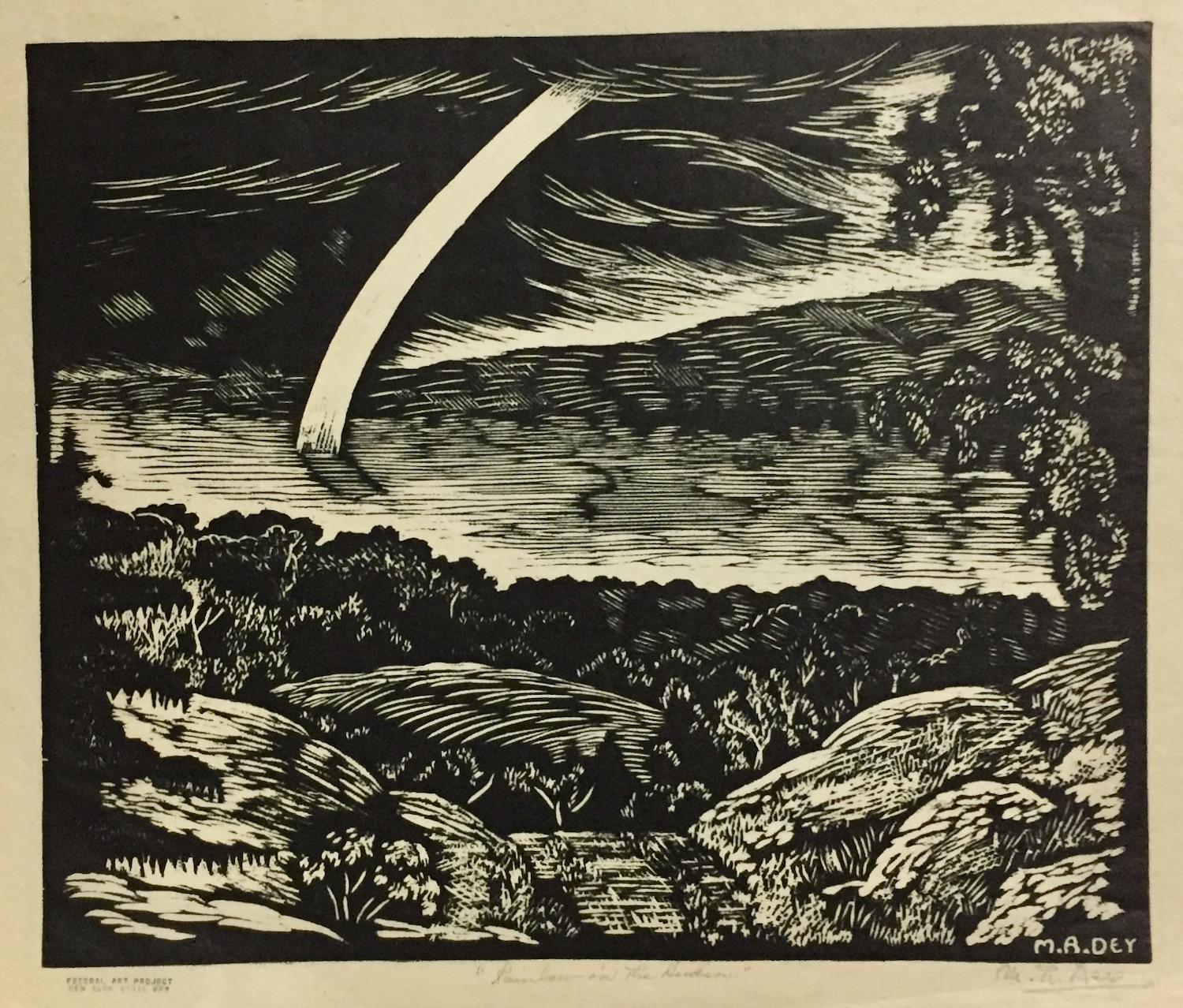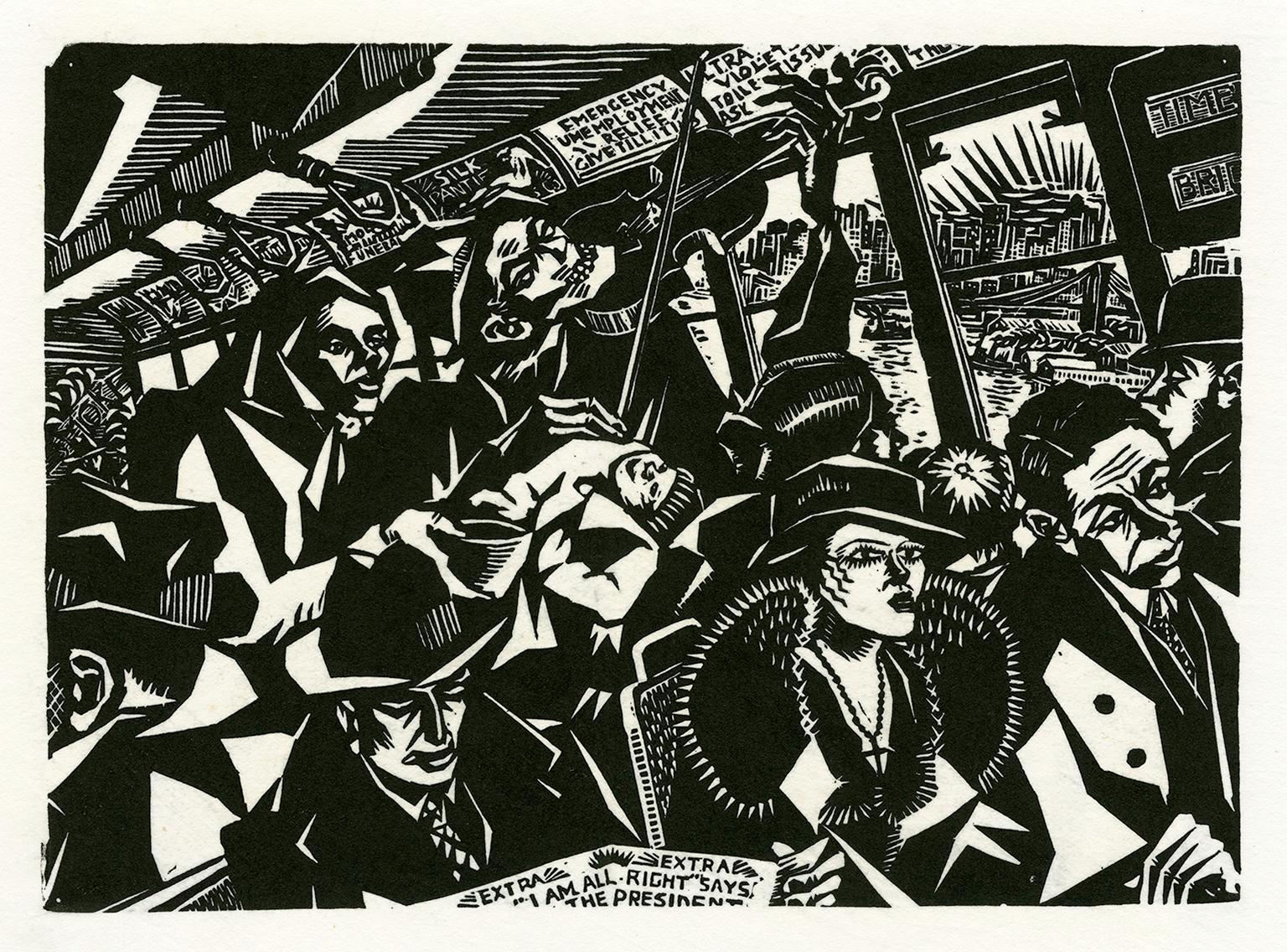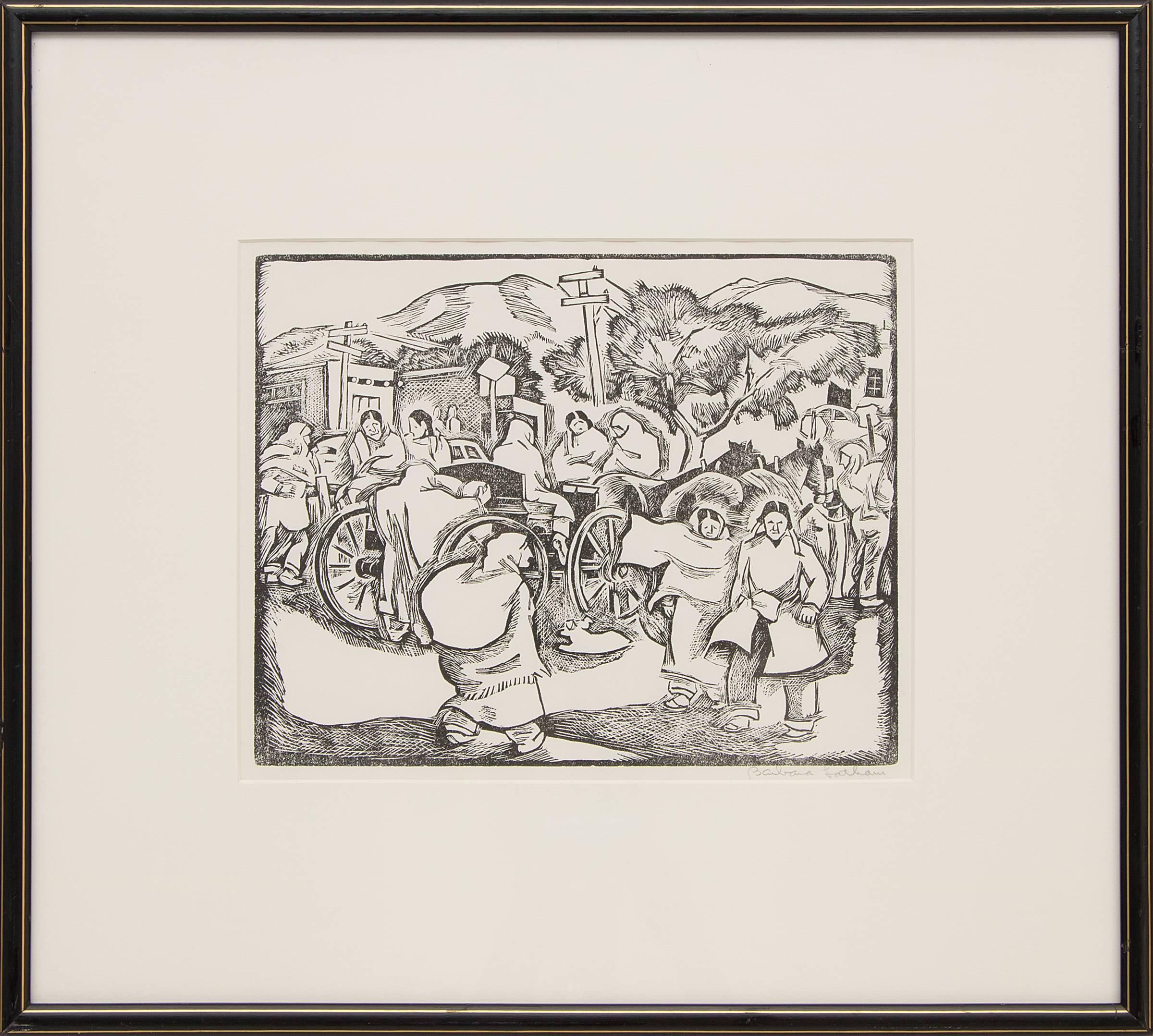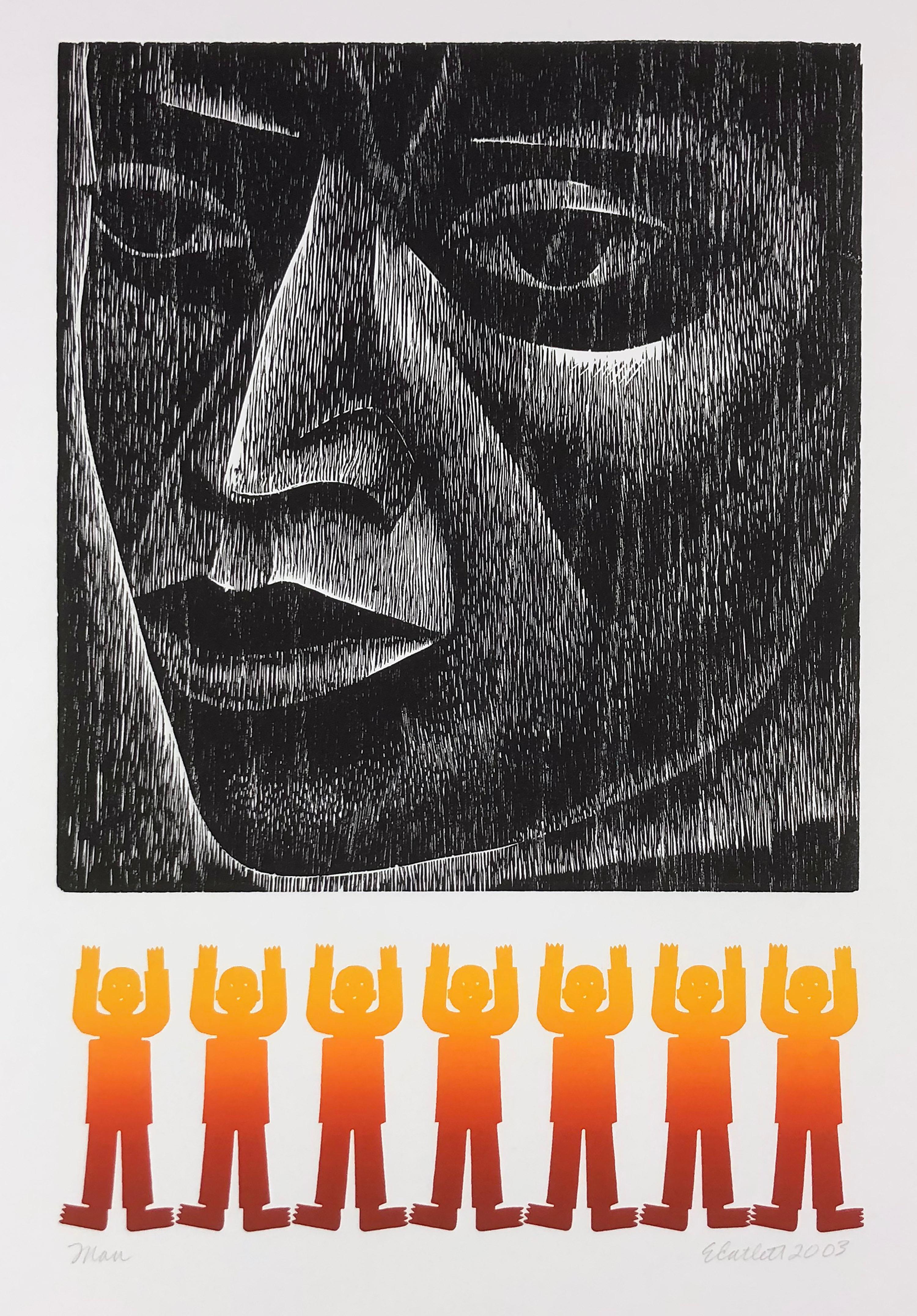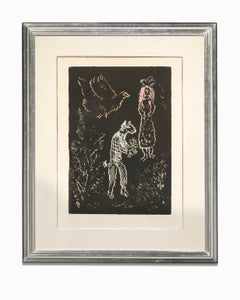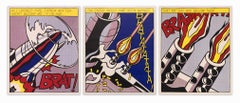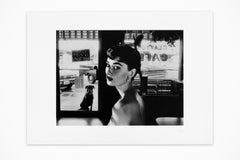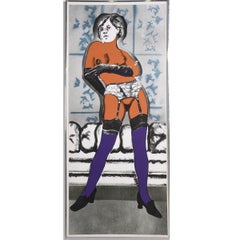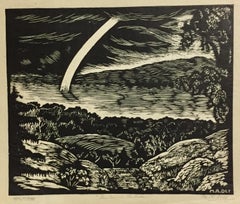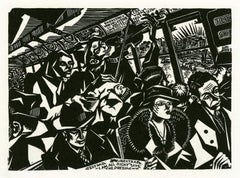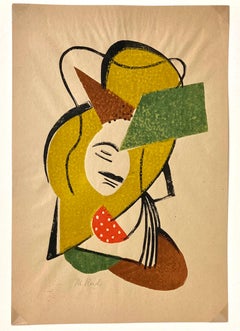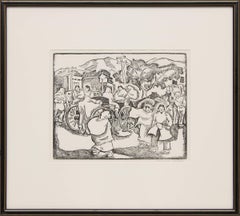Items Similar to "History of Detroit" Linoleum Cut, Black Ink, African American, Mural Style
Want more images or videos?
Request additional images or videos from the seller
1 of 9
Hubert Massey"History of Detroit" Linoleum Cut, Black Ink, African American, Mural Style2004
2004
About the Item
"History of Detroit" is in the style of a mural by the master muralist from the city of Detroit, Hubert Massey. It renders in dramatic composition the over 300 year history of this beautiful, eclectic city along the Detroit River waterway. Massey has included various nationalities starting with the Native Americans who called this home before Europeans arrived along with those Europeans and the African Americans who passed through on their way to freedom in Canada, and who served in the Civil War. This work is rich in stories and visuals. the print is called both a Linoleum Cut and/or a Linocut. It is a printmaking technique, a variant of woodcut in which a sheet of linoleum (sometimes mounted on a wooden block) is used for a relief surface. This printing is in an Edition of 100. The piece is 7.38 x 28 inches.
Hubert Massey is a Michigan artist who works in a variety of media to create large public art installations. Massey is noted for collaborating with communities to create art that tell their stories. His installations can be seen in Detroit at the Museum of African American History, Paradise Valley Park and Campus Martius. Massey is a graduate of Grand Valley State University and has studied at the University of London, Slade Institute of Fine Arts. He studied with Stephen Dimitroff and Lucienne Bloch, apprentices to muralist Diego Rivera, and is one of few African American artists painting in the true Buon Fresco style and the only known, African American commissioned fresco artist in America.
His bold, vibrant images can be spotted throughout the Detroit metropolitan region. Chances are if you’ve visited Mexican town, Greek town, the Cultural Center, Charles H. Wright Museum of African American History, Detroit Athletic Club or any number of other landmark community attractions, you’ve encountered the remarkable work of master artist Hubert Massey.
An award-winning Kresge Fine Arts Fellow, his distinctive fresco murals grace the halls of such visible
Michigan destinations as the Flint Institute of the Arts, Detroit Athletic Club, and his alma mater, Grand Valley State University, where he earned an honorary doctorate of fine arts in 2012. In 2014 the Detroit Regional Convention Facility Authority commissioned Hubert to create the first large-scale mural completed for Cobo Center since 1987. A fresco painting, the mural will feature images and tell stories of Detroit community pride.
“Public art begins with the community it will serve. In fact, after nearly 20 years of creating large-scale public works of art for various cities, communities and neighborhoods throughout the Midwest, it is my belief that public art should be, first and foremost, meaningful to those who surround it.” – Dr. Hubert Massey
- Creator:
- Creation Year:2004
- Dimensions:Height: 7.38 in (18.75 cm)Width: 28 in (71.12 cm)
- Medium:
- Movement & Style:
- Period:
- Condition:
- Gallery Location:Detroit, MI
- Reference Number:1stDibs: LU128616868262
About the Seller
5.0
Vetted Professional Seller
Every seller passes strict standards for authenticity and reliability
Established in 2014
1stDibs seller since 2019
106 sales on 1stDibs
Typical response time: 1 to 2 days
- ShippingRetrieving quote...Shipping from: Detroit, MI
- Return Policy
Authenticity Guarantee
In the unlikely event there’s an issue with an item’s authenticity, contact us within 1 year for a full refund. DetailsMoney-Back Guarantee
If your item is not as described, is damaged in transit, or does not arrive, contact us within 7 days for a full refund. Details24-Hour Cancellation
You have a 24-hour grace period in which to reconsider your purchase, with no questions asked.Vetted Professional Sellers
Our world-class sellers must adhere to strict standards for service and quality, maintaining the integrity of our listings.Price-Match Guarantee
If you find that a seller listed the same item for a lower price elsewhere, we’ll match it.Trusted Global Delivery
Our best-in-class carrier network provides specialized shipping options worldwide, including custom delivery.More From This Seller
View All"Nuit d'été (Summer's Night)" Lithograph, Colors, Linear Figures on Black Ground
By Marc Chagall
Located in Detroit, MI
SALE ONE WEEK ONLY
Marc Chagall is clearly a Modernist. Though titled "Summer Night" it could just as easily be identified as a scene from Shakespeare...
Category
Late 20th Century Modern Figurative Prints
Materials
Rag Paper, Lithograph
Roy Lichtenstein Tryptich "as I opened fire" 1966 Stedelijk Museum Amsterd
By Roy Lichtenstein
Located in Detroit, MI
SALE ONE WEEK ONLY
"As I opened fire" is a lithograph triptych by Roy Lichtenstein whose provenance is printed on verso: Coll. Stedelijk Museum Amsterdam. Editions were copyrighted by the Stedelijk Museum Amsterdam and corrected with the original and printed in the Netherlands. Each piece measures: 25 1/8" h x 20 5/8" w.
Roy Fox Lichtenstein was an American pop artist. During the 1960s through the 90’s, along with Andy Warhol, Jasper Johns, and James Rosenquist, he became a leading figure in the new art movement. His work defined the premise of pop art through parody. Most of Lichtenstein's best-known works are relatively close, but not exact, copies of comic book panels, a subject he largely abandoned in 1965. Lichtenstein's Still Life paintings, sculptures and drawings, which span from 1972 through the early 1980s, cover a variety of motifs and themes, including the most traditional such as fruit, flowers, and vases.
Inspired by the comic strip, Lichtenstein produced precise compositions that documented while they parodied, often in a tongue-in cheek manner. His work was influenced by popular advertising and the comic book style. His artwork was considered to be "disruptive". He described pop art as "not 'American' painting but actually industrial painting". His paintings were exhibited at the Leo Castelli Gallery in New York City.
Wham!, and Drowning Girl Look Mickey proved to be his most influential works. His most expensive piece is Masterpiece which was sold for $165 million in January 2017.
Lichtenstein received both his Bachelors and Masters at Ohio State University, Columbus, Ohio where he taught for ten years. In 1967, he moved back to upstate New York and began teaching again.
It was at this time that he adopted the Abstract Expressionist style, being a late convert to this style of painting. Lichtenstein began teaching in upstate New York at the State University of New York at Oswego in 1958. About this time, he began to incorporate hidden images of cartoon characters such as Mickey Mouse and Bugs Bunny into is abstract works.
In 1960, he started teaching atRutgers University where he was heavily influenced by Allan Kaprow, who was also a teacher at the university. This environment helped reignite his interest in Proto-pop imagery. In 1961, Lichtenstein began his first pop paintings using cartoon images and techniques derived from the appearance of commercial printing. This phase would continue to 1965, and included the use of advertising imagery suggesting consumerism and homemaking. His first work to feature the large-scale use of hard-edged figures and Ben-Day dots was Look Mickey (1961), National Gallery of Art, Washington, D. C.) This piece came from a challenge from one of his sons, who pointed to a Mickey Mouse comic book and said; "I bet you can't paint as good as that, eh, Dad?" In the same year he produced six other works with recognizable characters from gum wrappers and cartoons.
It was at this time that Lichtenstein began to find fame not just in America but worldwide. He moved back to New York to be at the center of the art scene in 1964 to concentrate on his painting. Lichtenstein used oil and Magna (early acrylic) paint in his best known works, such as Drowning Girl (1963), which was appropriated from the lead story in DC Comics’ Secret Hearts No. 83, drawn by Tony Abruzzo. (Drowning Girl now hangs in the Museum of Modern Art, New York.) Drowning Girl also features thick outlines, bold colors and Ben-Day dots, as if created by photographic reproduction. Of his own work Lichtenstein would say that the Abstract Expressionists "put things down on the canvas and responded to what they had done, to the color positions and sizes. My style looks completely different, but the nature of putting down lines pretty much is the same; mine just don't come out looking calligraphic, like Pollock’s or Kline’s.
Rather than attempt to reproduce his subjects, Lichtenstein's work tackled the way in which the mass media portrays them. He would never take himself too seriously, however, saying: "I think my work is different from comic strips – but I wouldn't call it transformation; I don't think that whatever is meant by it is important to art.” When Lichtenstein's work was first exhibited, many art critics of the time challenged its originality. His work was harshly criticized as vulgar and empty. The title of a Life magazine article in 1964 asked, "Is He the Worst Artist in the U.S.?" Lichtenstein responded to such claims by offering responses such as the following: "The closer my work is to the original, the more threatening and critical the content. However, my work is entirely transformed in that my purpose and perception are entirely different. I think my paintings are critically transformed, but it would be difficult to prove it by any rational line of argument.”
In 1969, Lichtenstein was commissioned by Gunter Sachs to create Composition and Leda and the Swan, for the collector's Pop Art bedroom suite at the Palace Hotel in St. Moritz. In the late 1970s and during the 1980s, Lichtenstein received major commissions for works in public places: the sculptures Lamp (1978) in St. Mary's, Georgia; Mermaid (1979) in Miami Beach; the 26 feet tall Brushstrokes in Flight (1984, moved in 1998) at John Glenn Columbus International Airport; the five-storey high Mural with Blue Brushstroke (1984–85) at the Equitable Center, New York and El Cap de Barcelona (1992) in Barcelona. In 1994, Lichtenstein created the 53-foot-long, enamel-on-metal Times Square Mural in Times Square subway station. In 1977, he was commissioned by BMW to paint a Group 5 Racing Version of the BMW 320i for the third installment in the BMW Art Car Project. The DreamWorks Records logo was his last completed project. "I'm not in the business of doing anything like that (a corporate logo) and don't intend to do it again," allows Lichtenstein. "But I know Mo Ostin and David Geffen and it seemed interesting.
In 1996 the The National Gallery of Art in Washington, D.C. became the largest single repository of the artist's work when Lichtenstein donated 154 prints and 2 books. The Art Institute of Chicago has several important works by Lichtenstein in its permanent collection, including Brushstroke with Spatter (1966) and Mirror No. 3 (Six Panels) (1971). The personal holdings of Lichtenstein's widow, Dorothy Lichtenstein, and of the Roy Lichtenstein Foundation number in the hundreds. In Europe, the Museum Ludwig in Cologne has one of the most comprehensive Lichtenstein holdings with Takka Takka (1962), Nurse (1964), Compositions I (1964), besides the Frankfurt Museum fur Modern Kunst with We Rose Up slowly (1964), and Yellow and Green Brushstrokes...
Category
1960s Pop Art Figurative Prints
Materials
Lithograph
Axel Crieger Audrey Hepburn Fotocollage Print "Fragility Adored" Ltd Ed
By Axel Crieger
Located in Detroit, MI
SALE ONE WEEK ONLY
"Fragility Adored" a Fotocollage print on photographic paper by Axel Crieger (1955 - ) of an Audrey Hepburn publicity photo for "Sabrina" now placed in a cafe. It is mounted on upper edges of sheet under paste-partout, monogrammed and numbered #77/99 in a felt-tip pen on the lower right. He has signed it both on the photo and on the surrounding mat.
Alex Crieger is a world-reknown artist, designer and photographer. He lives and works in Los Angeles. His digital paintings have a rich and profound pictorial space that invites the viewer into it and makes him/her a silent participant of the story.
His digital collaged images depict celebrities in dreamlike settings as advertisement of luxury products giving the images an original new look. Alex’s digital paintings are composed of a variety of photographic quotes, designs, drawings and special effects to create photographic images he has not always taken but collaged into new uniquely composed settings.
Crieger is a photographer who makes art photographs we wish to be real. He’s created compositions of Steve McQueen or Brigitte Bardot that are more beautiful than the truth. A combination of sketches, digital effects and a spectacular design yield classic photographs that have never been photographed. For example, Brigitte still exudes in Paris and an eternally young James Dean poses for a propeller plane. Crieger has already produced several exhibitions at international art shows and galleries. Many museums of contemporary art also exhibit his work.
He studied visual communications and has worked as a photographer, director and designer for international clients in New York, Los Angeles, Paris, London and Milan. His work as garnered critical acclaim and numerous awards and is produced in small editions. In addition to photography, Crieger also worked as a director and designer for international clients in New York, Los Angeles, Paris, London and Milan. He has created advertisements, exhibitions and a variety of designs and large paintings. Alex Crieger even published the book American Night...
Category
1950s Conceptual Figurative Prints
Materials
Photographic Paper
Larry Rivers Lithograph "For Adults Only I" Corseted Nude Female
By Larry Rivers
Located in Detroit, MI
"For Adults Only I" is an exquisite offset lithograph print with colors of an alluring corseted and stockinged nude female in a confrontational pose filling the frame inviting the vi...
Category
1970s Pop Art Figurative Prints
Materials
Lithograph, Offset
Antonio Lopez Saenz Aquatint "Hombres y Sillos" (Men and Chairs)
By Antonio Lopez Saenz 1
Located in Detroit, MI
SALE ONE WEEK ONLY
Antonio Lopez Saenz is a brilliant iconic creative artist from Mazatlan, Mexico. The aquatint “Hombres y Sillos” (Men and Chai...
Category
1980s Contemporary Figurative Prints
Materials
Aquatint
Antonio Lopez Saenz Aquatint "Pareja" (Partner)
By Antonio Lopez Saenz 1
Located in Detroit, MI
SALE ONE WEEK ONLY
Antonio Lopez Saenz is a brilliant iconic creative artist from Mazatlan, Mexico. The aquatint “Pareja” (Partner) was created in...
Category
1980s Contemporary Figurative Prints
Materials
Aquatint
You May Also Like
Maurice Robert Dey, Rainbow on the Hudson
Located in New York, NY
Biographical information on Maurice Robert Dey is hard to find. He was born on 1899 (or maybe 1900), in Switzerland. As an adult he lived and worked in Woodstock, the NY artists' c...
Category
1930s American Modern Landscape Prints
Materials
Linocut
'Modern Music' — WPA Modernism, New York City El
Located in Myrtle Beach, SC
Albert Potter, 'Modern Music' also Twilight Melodies', linocut, c. 1935, from the posthumous edition of 20, printed in 1977, authorized by the artist’s widow. Estate authenticated in...
Category
1930s American Modern Figurative Prints
Materials
Linocut
Martha Reed, (Color Abstraction) (Head?)
By Martha Reed
Located in New York, NY
Martha Reed was the daughter of the artist Doel Reed and as an adult she joined her parents in Taos, New Mexico.
There she designed clothes with a south-we...
Category
Mid-20th Century American Modern Abstract Prints
Materials
Linocut
Saturday Morning Market, Taos Plaza, New Mexico, 1950s Figural Linocut Print
By Barbara Latham
Located in Denver, CO
"Saturday Morning (Market, Taos Plaza, New Mexico)" is a striking 1950s modernist linocut print by renowned New Mexican artist Barbara Latham. This vivid print captures a bustling Sa...
Category
Mid-20th Century American Modern Figurative Prints
Materials
Linocut
Reclining Nude
By Irene Zevon
Located in Buffalo, NY
An original linocut print by American artist Irene Zevon. The reclining nude is one of Zevon's most coveted subject matters. This 1959 print is one of a series of ten prints.
Category
1950s American Modern Figurative Prints
Materials
Paper, Linocut
Man
By Elizabeth Catlett
Located in Missouri, MO
Elizabeth Catlett
“Man” 1975 (The Print Club of Cleveland Publication Number 83, 2005)
Woodcut and Color Linocut
Printed in 2003 at JK Fine Art Editions Co., Union City, New Jersey
Signed and Dated By The Artist Lower Right
Titled Lower Left
Ed. of 250
Image Size: approx 18 x 12 inches
Elizabeth Catlett (1915-2012) is regarded as one of the most important women artists and African American artists of our time. She believed art could affect social change and that she should be an agent for that change: “I have always wanted my art to service black people—to reflect us, to relate to us, to stimulate us, to make us aware of our potential.” As an artist and an activist, Catlett highlighted the dignity and courage of motherhood, poverty, and the working class, returning again and again to the subject she understood best—African American women.
The work below, entitled, “Man”, is "carved from a block of wood, chiseled like a relief. Catlett, a sculptor as well as a printmaker, carves figures out of wood, and so is extremely familiar with this material. For ‘Man’ she exploits the grain of the wood, allowing to to describe the texture of the skin and form vertical striations, almost scarring the image. Below this intense, three-dimensional visage parades seven boys, printed repetitively from a single linoleum block in a “rainbow roll” that changes from gold to brown. This row of brightly colored figures with bare feet, flat like a string of paper dolls, raise their arms toward the powerful depiction of the troubled man above.”
Biography:
Elizabeth Catlett (1915-2012)
Known for abstract sculpture in bronze and marble as well as prints and paintings, particularly depicting the female figure, Elizabeth Catlett is unique for distilling African American, Native American, and Mexican art in her work. She is "considered by many to be the greatest American black sculptor". . .(Rubinstein 320)
Catlett was born in Washington D.C. and later became a Mexican citizen, residing in Cuernavaca Morelos, Mexico. She spent the last 35 years of her life in Mexico.
Her father, a math teacher at Tuskegee Institute in Alabama, died before she was born, but the family, including her working mother, lived in the relatively commodious home of his family in DC. Catlett received a Bachelor of Arts degree from Howard University, where there was much discussion about whether or not black artists should depict their own heritage or embrace European modernism.
She earned a Master of Fine Arts degree in 1940 from the University of Iowa, where she had gone to study with Grant Wood, Regionalist* painter. His teaching dictum was "paint what you know best," and this advice set her on the path of dealing with her own background. She credits Wood with excellent teaching and deep concern for his students, but she had a problem during that time of taking classes from him because black students were not allowed housing in the University's dormitories.
Following graduation in 1940, she became Chair of the Art Department at Dillard University in New Orleans. There she successfully lobbied for life classes with nude models, and gained museum admission to black students at a local museum that to that point, had banned their entrance. That same year, her painting Mother and Child, depicting African-American figures won her much recognition.
From 1944 to 1946, she taught at the George Washington Carver School, an alternative community school in Harlem that provided instruction for working men and women of the city. From her experiences with these people, she did a series of paintings, prints, and sculptures with the theme "I Am a Negro Woman."
In 1946, she received a Rosenwald Fellowship*, and she and her artist husband, Charles White, traveled to Mexico where she became interested in the Mexican working classes. In 1947, she settled permanently in Mexico where she, divorced from White, married artist Francisco Mora...
Category
Late 19th Century American Modern Figurative Prints
Materials
Woodcut, Linocut
Price Upon Request
